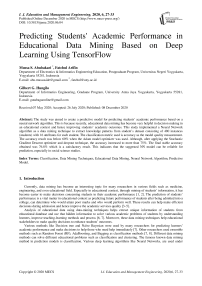Predicting Students' Academic Performance in Educational Data Mining Based on Deep Learning Using TensorFlow
Автор: Mussa S. Abubakari, Fatchul Arifin, Gilbert G. Hungilo
Журнал: International Journal of Education and Management Engineering @ijeme
Статья в выпуске: 6 vol.10, 2020 года.
Бесплатный доступ
The study was aimed to create a predictive model for predicting students’ academic performance based on a neural network algorithm. This is because recently, educational data mining has become very helpful in decision making in an educational context and hence improving students’ academic outcomes. This study implemented a Neural Network algorithm as a data mining technique to extract knowledge patterns from student’s dataset consisting of 480 instances (students) with 16 attributes for each student. The classification metric used is accuracy as the model quality measurement. The accuracy result was below 60% when the Adam model optimizer was used. Although, after applying the Stochastic Gradient Descent optimizer and dropout technique, the accuracy increased to more than 75%. The final stable accuracy obtained was 76.8% which is a satisfactory result. This indicates that the suggested NN model can be reliable for prediction, especially in social science studies.
Classification, Data Mining Techniques, Educational Data Mining, Neural Network Algorithm, Predictive Model
Короткий адрес: https://sciup.org/15017278
IDR: 15017278 | DOI: 10.5815/ijeme.2020.06.04
Список литературы Predicting Students' Academic Performance in Educational Data Mining Based on Deep Learning Using TensorFlow
- S. K. Mohamad and Z. Tasir, “Educational Data Mining: A Review,” Procedia - Soc. Behav. Sci., vol. 97, pp. 320–324, 2013.
- M. Chalaris, S. Gritzalis, M. Maragoudakis, C. Sgouropoulou, and A. Tsolakidis, “Improving Quality of Educational Processes Providing New Knowledge Using Data Mining Techniques,” Procedia - Soc. Behav. Sci., vol. 147, pp. 390–397, 2014.
- B. Brijesh Kumar and P. Saurabh, “Mining Educational Data to Analyze Students‟ Performance,” Int. J. Adv. Comput. Sci. Appl., vol. 2, no. No. 6, pp. 59–63, 2011.
- W. F. W. Yaacob, S. A. M. Nasir, W. F. W. Yaacob, and N. M. Sobri, “Supervised data mining approach for predicting student performance,” Indones. J. Electr. Eng. Comput. Sci., vol. 16, no. 3, pp. 1584–1592, 2019.
- H. Aldowah, H. Al-Samarraie, and W. M. Fauzy, “Educational data mining and learning analytics for 21st century higher education: A review and synthesis,” Telemat. Informatics, vol. 37, pp. 13–49, 2019.
- S. Hussain, N. A. Dahan, F. M. Ba-Alwib, and N. Ribata, “Educational data mining and analysis of students’ academic performance using WEKA,” Indones. J. Electr. Eng. Comput. Sci., vol. 9, no. 2, pp. 447–459, 2018.
- S. S. M. Ajibade, N. B. Ahmad, and S. M. Shamsuddin, “A data mining approach to predict academic performance of students using ensemble techniques,” in Advances in Intelligent Systems and Computing, 2020, vol. 940, no. March, pp. 749–760.
- E. A. Amrieh, T. Hamtini, and I. Aljarah, “Mining Educational Data to Predict Student’s academic Performance using Ensemble Methods,” Int. J. Database Theory Appl., vol. 9, no. 8, pp. 119–136, 2016.
- A. M. Shahiri, W. Husain, and N. A. Rashid, “A Review on Predicting Student’s Performance Using Data Mining Techniques,” in Procedia Computer Science, 2015, vol. 72, pp. 414–422.
- R. Singh, “An Empirical Study of Applications of Data Mining Techniques for Predicting Student Performance in Higher Education,” Int. J. Comput. Sci. Mob. Comput., vol. 2, no. February, pp. 53–57, 2013.
- S. Borkar and K. Rajeswari, “Predicting students academic performance using education data mining,” Int. J. Comput. Sci. Mob. Comput., vol. 2, no. 7, pp. 273–279, 2013.
- B. Guo, R. Zhang, G. Xu, C. Shi, and L. Yang, “Predicting Students Performance in Educational Data Mining,” in Proceedings - 2015 International Symposium on Educational Technology, ISET 2015, 2016, pp. 125–128.
- D. Kabakchieva, “Predicting student performance by using data mining methods for classification,” Cybern. Inf. Technol., vol. 13, no. 1, pp. 61–72, 2013.
- D. Kabakchieva, K. Stefanova, and V. Kisimov, “Analyzing university data for determining student profiles and predicting performance,” in EDM 2011 - Proceedings of the 4th International Conference on Educational Data Mining, 2011, pp. 347–348.
- J. Lara-Rubio, A. F. Villarejo-Ramos, and F. Liébana-Cabanillas, “Explanatory and predictive model of the adoption of P2P payment systems,” Behav. Inf. Technol., vol. 0, no. 0, pp. 1–14, 2020.
- E. A. Amrieh, T. Hamtini, and I. Aljarah, “Preprocessing and analyzing educational data set using X-API for improving student’s performance,” in 2015 IEEE Jordan Conference on Applied Electrical Engineering and Computing Technologies, AEECT 2015, 2015.
- P. S. Janardhanan, “Project repositories for machine learning with TensorFlow,” Procedia Comput. Sci., vol. 171, pp. 188–196, 2020.
- L. Hao, S. Liang, J. Ye, and Z. Xu, “TensorD: A tensor decomposition library in TensorFlow,” Neurocomputing, vol. 318, pp. 196–200, 2018.
- R. Orus Perez, “Using TensorFlow-based Neural Network to estimate GNSS single frequency ionospheric delay (IONONet),” Adv. Sp. Res., vol. 63, no. 5, pp. 1607–1618, 2019.
- V.-H. Nhu et al., “Effectiveness assessment of Keras based deep learning with different robust optimization algorithms for shallow landslide susceptibility mapping at tropical area,” CATENA, vol. 188, p. 104458, 2020.
- K. Akyol, “Comparing of deep neural networks and extreme learning machines based on growing and pruning approach,” Expert Syst. Appl., vol. 140, p. 112875, 2020.


